User Manual
Battery Container
PowerTitan 2.0-ST5015UX-2H-US/ST5015UX-4H-US
PowerTitan 2.0-
ST5015UX-2H-US/ST5015UX-4H-
USBattery ContainerUser
ManualST5015UX-2H-US_
ST5015UX-4H-US-SEN-Ver10-
202406M-D-000933
ST5015UX-2H-US_ST5015UX-4H-US-SEN-Ver10-202406

Need help?
Do you have a question about the ST5015UX-2H-US and is the answer not in the manual?
Questions and answers